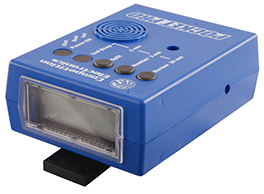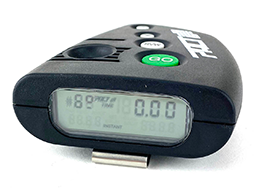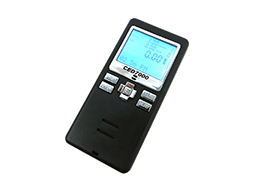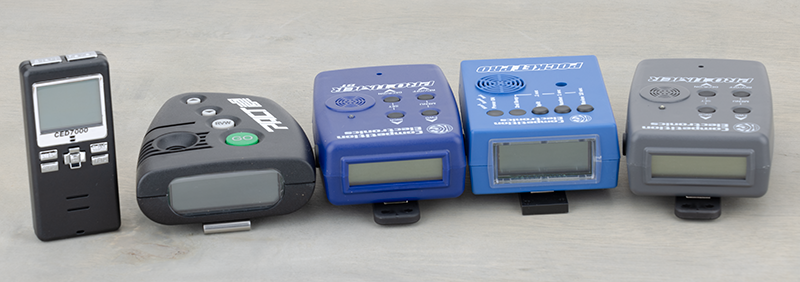All About Shot Timers by Joel Park
Posted by Joel Park on Aug 25th 2024
All About Shot Timers
Picking a shot timer is a lot like picking a wristwatch. Each shot timer has slightly different attachment methods, functions, menus, sizes, etc. I’ve spent the last several months switching between timers in my own training and have some thoughts to share on features I look for and nuances that I find make the product less enjoyable.
There are a few features to explain, that I will commonly reference, in case you aren’t familiar with timers:
Instant and delay are modes for the timer that determine if the timer will beep as soon as the button is pressed or if there will be a delay in the beep after the button is pressed. Anyone training on their own, in live or dryfire, will want to use the delay feature so you have time to move your hands to the desired start position before the beep goes off.
Par time is a feature that allows a time limit to be set so the timer will beep at the beginning and end of the specified time.
Competition Electronics Pocket Pro
The Pocket Pro timer is popular for a lot of reasons. It’s simple to navigate and the buttons are labeled well. Due to its ease of use, most users can figure it out without the need for reading instructions or a lot of trial and error. The most useful feature for me is the toggle switch on the side of the timer. It switches between instant and delay without needing to click through any menus. The par time is also very easy to adjust.
The timer uses a 9-volt battery and the pocket clip is easy to use. The downside is the timer feels fragile enough that you don’t want to drop them. The screens can easily crack, but they are still usable and can be read even while cracked
Competition Electronics Pro Timer – Previously named the Pocket Pro 2
The Pro Timer/Pocket Pro 2 is my current favorite. The housing and pocket clip are similar to the Pocket Pro, but the toggle switch on the side of the timer for instant and delay is gone. With this model, the change between instant and delay must be made in the menu. The menu is a little more involved to operate, but with the busier menu comes a few improvements. In my opinion, one of the best new features is the ability to adjust the volume of the beep. While the volume change isn’t that useful for outdoors, it’s very nice for keeping the noise down during indoor dryfire, especially if you need to be considerate of others.
The menu on the Pocket Pro 2 is easy to navigate for par times and you can easily adjust the minimum and maximum start time before the delay. The screen is backlit unlike the original Pocket Pro model and the timer also uses a 9-volt battery.
PACT Club 3 Timer
The Pact Club 3 timer is very simple to operate and feels a lot more rugged in its construction. These timers appear to be very durable. My club has used these during matches for years with very little issue, despite getting rained on, dropped, etc. The buttons are rubber compared to plastic buttons on the other timers. Unfortunately, the buttons can stick sometimes.
The timer is very simple to operate with only four buttons. To select instant/delay and par times is easily adjusted by pressing two of the buttons together. This activates the menu and then you press the up or down arrow to make a selection. The timer uses a 9-volt battery and my only critique is the pocket clip is tough to use. The clip is folded metal and is more difficult to thread onto your pocket or belt than the previous timers. It’s not a timer I would want to pass back and forth or take on and off my belt often. Lastly, the beep is one of the loudest of the group I’ve been testing with no volume control. If you use this in dryfire, you will likely want to put tape over the speaker or something to dull it a bit. The timer runs off a 9 volts battery.
CED7000 Timer
I tried really hard to like the CED 7000, but there were a lot of features that just didn’t fit for me. The first thing that jumps out is the lack of a pocket clip. I realize some people prefer to hold the timer like a stopwatch or wear it around their neck, but it’s not comfortable for me and constantly got in the way.
The menu has a LOT of features and adjustability, but it was too complicated to navigate. I had to use the instructions to figure most things out. This isn’t a timer you can just take out of the box and figure out if you have never used it before. Unlike the previous timers, this one offers an internal rechargeable battery, if that’s desirable to you.
Kestrel KST1000 Timer
I had one of the worst customer experiences I’ve ever had with the Kestrel timer. I purchased the timer online and out of the box, it wouldn’t register shots. I did a factory update, firmware upgrade, and adjusted the sensitivity to every level and none of them would register gunshots. I contacted customer service via Kestrel’s site with a detailed explanation and received a response to send the timer in.
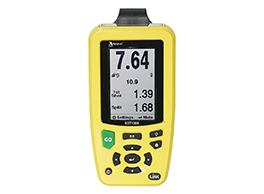
Around a month after I’d sent the timer in, I emailed customer service asking if there was a repair estimate on my timer. I didn’t receive a response, so a week later I used a different contact us feature for Kestrel and didn’t receive a response from that request either. Around 45 days after I sent the timer in, I called their customer service number and it just rang to voicemail. I left a voicemail and decided I’d just let it play out to see if I ever heard from them again.
A few weeks later, a friend made an Instagram post asking for timer recommendations. I recommend the Pocket Pro or Pact and recommended against the Kestrel and briefly shared my experience so far. As luck would have it, a Kestrel customer service rep replied to the main poster in the comments and assured it would be taken care of. I DM’ed the customer service rep screen caps of the emails I’d sent and the RMA. The rep read my messages, but never replied to me. A few days later I received an email with a service slip listing my timer as unrepairable and a new timer was being sent. I DM’ed the customer service person a second time thanking him for his help. He read that message also, and never replied to me. This left a lasting impression.
The Kestrel has the loudest buzzer volume, so I plan to use one as my primary timer for teaching since it will make it easier for everyone to hear start signals. Otherwise, I find the timer to be underwhelming overall and the lack of customer service and the $300 price tag make it a model I’d recommend against purchasing.
Other Brands
The Shooter’s Global and AMG Commander have followings and lots of testimonials, but I do not have much experience with them. If that changes in the future I will follow up.
Conclusion
When you are choosing a timer, you must decide what features are most important to you and what you need to accomplish. Every timer has its own quirks and one man’s junk might be another man’s treasure. When I choose a timer, the ability to toggle between random and instant start is the most important feature, because I switch back and forth often. The second most important feature to me is how easily it attaches to my pocket, and if it will stay put while I’m running around. Adjusting par times is third on my list, which brings up my last point. The importance of par times to me has changed throughout my shooting career. Once upon a time, I would rarely dryfire without having a par set, now I don’t use them as much. As your shooting and training changes, the functions you prioritize will likely change also. In the end, you’ll be able to make any timer work. Regardless of which model you choose; it should be a heavily used item while you train.


